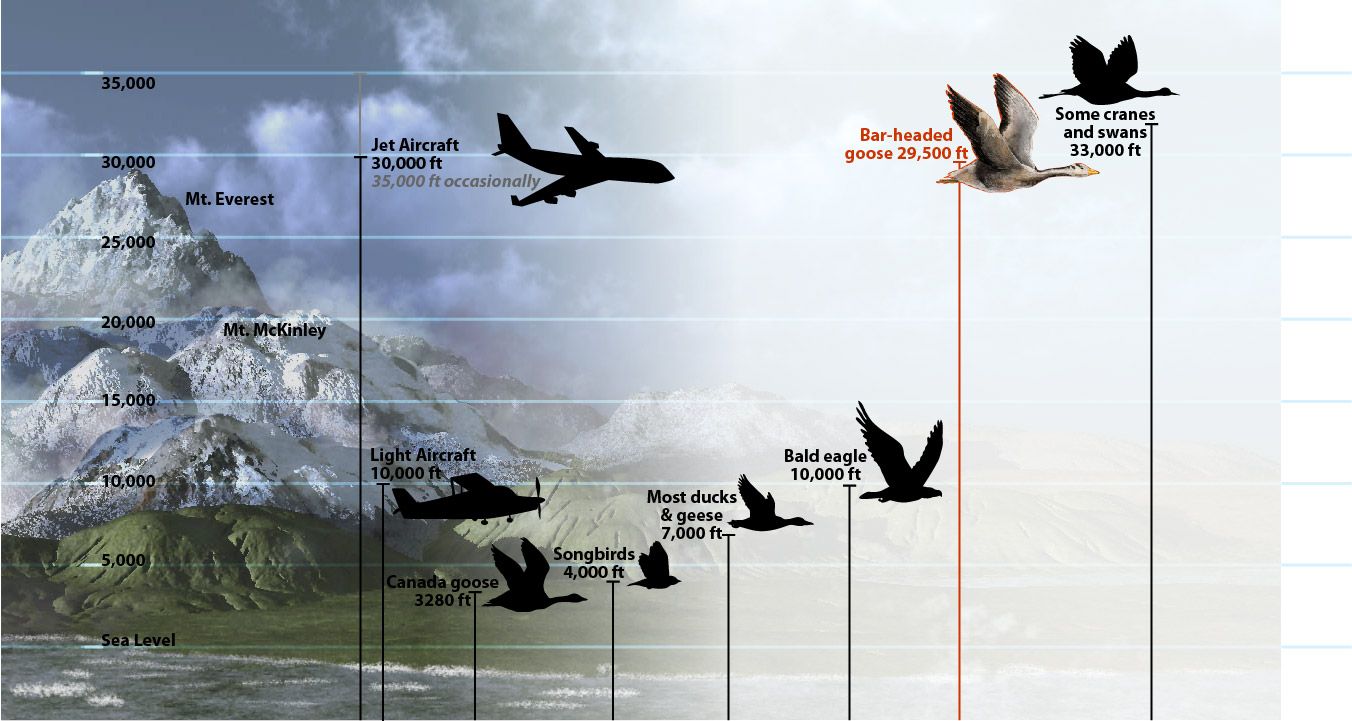Bar-headed goose in flight (Photo Nyambayar Batbayar)
A tracking study has revealed the secrets of the Himalayan flight of the bar-headed goose - the world's highest bird migration.
The geese have been recorded at heights of more than 7,000m (23,000 ft) and mountaineers have claimed they have seen the birds fly over Mount Everest.
Their ability to fly in such extreme conditions has fascinated scientists for decades, as the BBC's science reporter Victoria Gill reports. (BBC News)

A pale grey goose with an orange beak and legs and two striking black bars on the head. It lives in central Asia. It is monotypic (males and females look the same) and mates for life.
The bar-headed goose is famous as it is widely believed to make the highest altitude migration on earth. While there was an anecdotal report of a flock of bar-headed geese being heard flying over Mt Makalu (the fifth highest mountain on earth), an unconfirmed report of them being seen flying over Everest has become legend. Such a migration would be incredibly demanding – at altitude the ambient pressure is dramatically reduced, meaning that there is less oxygen available and that the air can support less lift for flight (particularly for species that flap, like geese). This has puzzled biologists and physiologists for years:
"there must be a good explanation for why the birds fly to the extreme altitudes... particularly since there are passes through the Himalaya at lower altitudes, and which are used by other migrating bird species" Black & Tenney (1980).
As part of a large international research project, led by Bangor University and primarily supported by the BBSRC (grant BB/F015615/1) and the Max Planck Institute, bar-headed geese have now been GPS tracked flying over the Himalaya and data reveal that they do not normally fly higher than 6,300 m elevation, flying through the Himalayan passes rather than over the peaks of the mountains. This altitude is clearly still very impressive (equivalent to Everest Camp II) and challenges even the fittest human climbers. Without proper acclimatisation to such altitudes, mammals suffer from high altitude related sickness very quickly, and in some cases this can be fatal.
Bar-headed geese don’t need the wind
It has also been long believed that bar-headed geese use jet stream tail winds to facilitate their flight across the Himalaya. Surprisingly, latest research has shown that despite the prevalence of predictable tail winds that blow up the Himalayas (in the same direction of travel as the geese), bar-headed geese spurn the winds, waiting for them to die down overnight, when they then undertake the greatest rates of climbing flight ever recorded for a bird, and sustain these climbs rates for hours on end.
How can they cope?
Bar-headed geese are known to have a suite of physiological adaptations to help them deal with the low Oxygen (hypoxia) conditions at altitude:
- Bar-headed geese have a slightly larger wingspan and lower wing loading than other similar goose species (Lee et al. 2008), yielding greater lift and reducing the power required for flight (Pennycuick 1972).
- Their flight muscle is better supplied with fresh oxygenated blood than other waterfowl (Fedde et al. 1985, Snyder et al. 1984, Scott et al. 2009).
- Bird lungs are superior to mammalian lungs, having a counter exchange system, which extracts O2 much more efficiently (Ramirez et al. 2007) and they are larger in bar-headed geese than in other species of waterfowl (Scott et al. 2009).
- In hypoxic conditions, bar-headed geese can hyperventilate 7.2 times faster than their rate at sea level, and suffer no ill effects as a result of this (which increases blood pH – in humans this makes us restrict blood flow to the brain, causing a dizzy sensation).
- Bar-headed geese can also increase cardiac output (heart rate and volume of blood pumped) in hypoxia to 5 times the rate at sea-level when resting (Black & Tenney 1980, although note this can also occur in low altitude bird species too).
- Their haemoglobin is also adapted to load more O2 to the blood than most other vertebrates (Hiebl & Braunitzer 1988, Weber et al 1993, Liang et al. 2001).

It's not my first time to pay a quick visit this site,
ReplyDeletei am visiting this web page dailly and take fastidious facts
from here all the time.
Feel free to surf to my web-site :: CrystaUChappelle
I am really grateful to the owner of this site who has
ReplyDeleteshared this enormous post at here.
Feel free to visit my blog ... WarnerDDemetrakos
Wonderful goods from you, man. I've understand your stuff previous to and
ReplyDeleteyou're just extremely excellent. I really like what you've acquired here, really like what you are
saying and the way in which you say it. You make it enjoyable and you still take care
of to keep it smart. I can not wait to read far more from you.
This is really a tremendous web site.
Here is my webpage ... DanialPForister
It's very effortless to find out any topic on net as
ReplyDeletecompared to books, as I found this piece
of writing at this site.
Check out my homepage JohnathonNGanaway
Sweet blog! I found it while browsing on Yahoo
ReplyDeleteNews. Do you have any tips on how to get listed in Yahoo News?
I've been trying for a while but I never seem to get there!
Appreciate it
Look at my weblog - KirbyDSection
Thanks in favor of sharing such a good idea,
ReplyDeletepiece of writing is pleasant, thats why i have read it completely
Feel free to visit my page - CortneyWBardis